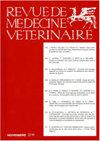Dermopatías en burros de trabajo (Equus asinus) en áreas rurales de Córdoba (Colombia)
Q2 Veterinary
引用次数: 1
Abstract
A retrospective study was performed of the clinical histories of dermopathies diagnosed in working donkeys in the Ambulatory Medical Service of Large Animals of the Faculty of Veterinary Medicine at the Universidad de Cordoba, from January 2008 to December 2015. The objective was to determine the frequency of skin diseases in donkeys ( Equus asinus ). A total of 238 cases of dermopathies were treated, but the most frequently diagnosed cases were: traumatic wounds (26.4%), tick ectoparasitism (19.7%), dermatophytosis (16.3%), sarcoids (8.9%), habronemiasis (7.1%), pythiosis (6.3%), scabies (5.4%), myiasis (4.6%), abscesses (2.9%), dermatophilosis (1.7%), papillomatosis (0.4%), melanoma (0.4%), photosensitization (0.4%), and burns (0.4%). The most affected age group was between 5 and 10 years (60.3%), followed by young animals under 5 years old (20.8%), and those older than 10 years of age (19.2%). The major skin diseases diagnosed in donkeys were traumatic wounds, tick ectoparasitism, and dermatophytosis. This work is a significant contribution on the epidemiological status of different dermopathies, with their respective importance for management and control.cordoba(哥伦比亚)农村地区工作驴(Equus asinus)的皮肤病变
回顾性研究了2008年1月至2015年12月在科尔多瓦大学兽医学院大型动物流动医疗服务中心诊断的工作驴皮肤病的临床病史。目的是确定驴(Equus asinus)皮肤病的频率。共治疗皮肤病238例,其中诊断最多的为:创伤性伤口(26.4%)、蜱虫外寄生虫病(19.7%)、皮肤癣(16.3%)、结节病(8.9%)、habronemasis(7.1%)、pythiosis(6.3%)、疥疮(5.4%)、蝇蛆病(4.6%)、脓肿(2.9%)、皮肤癣病(1.7%)、乳头状瘤病(0.4%)、黑色素瘤(0.4%)、光致化(0.4%)、烧伤(0.4%)。发病年龄以5 ~ 10岁为主(60.3%),其次为5岁以下幼畜(20.8%)和10岁以上(19.2%)。驴的主要皮肤病是外伤、蜱外寄生虫病和皮肤真菌病。这项工作是对不同皮肤病的流行病学状况的重大贡献,具有各自的管理和控制的重要性。
本文章由计算机程序翻译,如有差异,请以英文原文为准。
求助全文
约1分钟内获得全文
求助全文
来源期刊

Revue De Medecine Veterinaire
农林科学-兽医学
CiteScore
1.30
自引率
0.00%
发文量
0
审稿时长
18-36 weeks
期刊介绍:
The Revue de Médecine Vétérinaire publishes four kinds of text:
1) Scientific reviews on subjects related to veterinary and comparative medicine. Suggested length: 10 to 30 typed pages.
2) Original reports on fundamental or applied research. Suggested length: 10 to 15 typed pages.
3) Continuous education articles, that should be easily understandable by non-specialists. Suggested length: 10 to 15 typed pages.
4) Clinical reports. Suggested length: 5 to 15 typed pages.
The publication can be done in French language or English language.
For an article written in English by not english native speakers authors, the manuscript must be subjected by attesting that it was read again by an anglophone scientist or a scientific translator.
The authors must certify that the manuscript was not published or subjected for publication to another review.
The manuscript must be accompanied by a sheet signed by all the joint authors indicating their agreement for the tender of the manuscript.
The publication is free but a financial participation could be required for the photographs color. An estimate will be sent to collect the agreement of the authors.
 求助内容:
求助内容: 应助结果提醒方式:
应助结果提醒方式:


